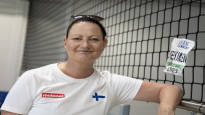At the under-23 European Championships in Espoo, Finland achieved its best ever medal haul. Team leader Eeva Kantomäki explains why.
Three golds and ten medals. For Finland, the under-23 European athletics championships organized in Espoo were a real success.
Finland was able to break its single-race medal record from the 1997 home games in Turku with one medal.
Finland was handsomely seventh in the medal table and the second best Nordic country after Norway. Sweden, which was left without a championship, was behind with its five medals.
On the closing day of the games, the champion of seipä was responsible for the latest Finnish medals Juho Alasaari as well as the javelin bronze medalist Anni-Linnea Alanen.
The change is quite big compared to the Games two years ago, because then the Finns won three medals. At that time, the age groups were those born in 1999–2001, while now they were born in 2001–2003.
In the six competition events of the under-23 European Championships preceding the Espoo Games, Finland had achieved a maximum of three medals at a time.
– This age group has also brought medals from the under-20 World Championships. This is a great age group. The harsh fact is that not many of this group will ever reach the prestigious medal for adults, Urheilu’s expert JAlphabet Ojaniemi resemble.
There were several Finnish teams at the Games, such as Alasaari, Eemil Helander 5,000 meters and 800 meters Veera Mattila.
Ojaniemi reminds us that results were seen from some Finns that would allow them to do well at the adult European level.
– Silja Kosonen the winning throw (73.71) would have won EC gold last summer. Alasaari’s 571, for example, would also be pretty close to the top in Europe.
Accustomed achievers
To the leader of the Finnish European Championship team Eeva to Kantomäki most of the athletes of the Finnish team are familiar from the previous two years. He served as team leader in the 2021 and 2022 under-20 championships.
A couple of years ago, the EC and WC teams consisted of athletes born in 2002–2003. The athletes brought five medals to Finland from both games. The brightest were those celebrating the championship in Espoo Saga VanninenSilja Kosonen and Alasaari.
Among the athletes born last year in 2003, Vanninen and Alasaari shone again at the World Championships in their age group.
The team leader can only glimpse the historic haul of ten medals.
– I knew that when I have traveled with this age group before, that there will be medals. It still manages to amaze me how they always perform and are brave. There is no uncertainty.
– I have told myself many times that Eve, enjoy this. You have to try to keep in mind that it doesn’t always go like this.
Kantomäki has already been involved in youth value competition trips 15 years ago. According to him, the general athletes born in 2002–2003 have certain aspects that separate them from other age groups.
– The archival training and the background team must be in order, but open-mindedness, joy, courage and cohesiveness can be seen in this group. Those are big things. It is not self-evident that a purely physical athlete can do well in value competitions, but it requires more.
